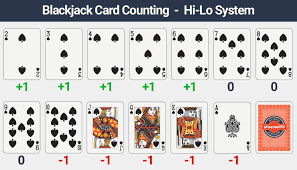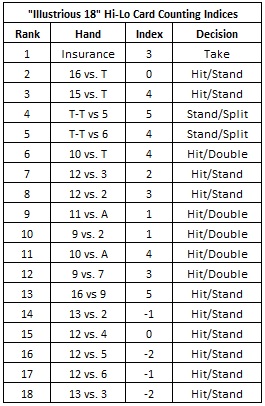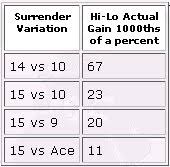
This is probably the most popular card counting system used in blackjack. It was introduced by Harvey Dubner in 1963, as a remake of Edward Thorp’s Ten-Count card counting system.
It is also known as the Plus/Minus system and is widely used by recreational players because it’s easy to learn and one can be ready to use it at a blackjack table after only a couple hours of practice.
System Classification
The Hi-Low system is classified as a balanced system because if you count out a full deck of cards, you will end at 0. It is basically a way to keep track of the high cards left in the deck.
How it Works
Once a shuffle has been completed and the game starts with a new deck, the count starts at 0. Each card is assigned a value of either -1, 0, or +1.
The chart of values is:
| 2 | 3 | 4 | 5 | 6 | 7 | 8 | 9 | 10 | J | Q | K | A |
| +1 | +1 | +1 | +1 | +1 | 0 | 0 | 0 | -1 | -1 | -1 | -1 | -1 |
A running count is kept as the cards are dealt. As each card is dealt, you either add 1, subtract 1 or do nothing to the count. That establishes the running count, which then needs to be converted to the true count.
A true count is a more accurate representation of the card values in a shoe. The true count is used when you’re dealing with more than one deck of cards, as in a game using a shoe to deal cards. It is calculated by the running count divided by the estimated decks remaining in the shoe.
A true count conversion is not necessary with a single deck game, because the running count is pretty accurate with one deck, when using a balanced counting system.
Figuring out the true count is what beginners fear, but it really isn’t that hard because you only have to estimate the number of remaining decks. At most, casinos are going to use an 8 deck shoe, so if it looks like you’ve played halfway through the shoe, there are approximately 4 decks remaining and you would divide your running count by 4.
When your true count is at 2, you can think about increasing your bet. When it increases more than that, continue increasing your bet upwards because the deck is very favorable.
However, don’t make huge increases in your bets if the count keeps going up or you will draw unwanted attention as a card counter.
With this system, and a true count of +1 or lower, it is suggested that minimum bets should be made.
Why Card Counting Helps
Once you get comfortable with this system and are able to keep an accurate true count, you can change your basic strategy moves because of the added knowledge you have about the remaining cards. You are able to turn losing decisions into profitable ones. For instance, if you have a ten/2 against the dealer’s 2, if the true count is +3, it would be better to stand, instead of hitting it, as basic strategy instructs. With that +3 count, you know that there are many more high cards than low cards, meaning you have a better chance of busting.


Decisions like that can be made because of a table of “index numbers,” developed by the blackjack expert Stanford Wong. The index numbers dictate the point at which basic strategy play for a specific decision changes. There are several different index number tables, but the 2 mostly used with the Hi-Lo system are the Illustrious 18 and the Fab 4, which you can find the full index number tables here.
Even the simplest card counting system makes basic strategy more effective because basic strategy assumes the next card drawn will be a 10. If you know for sure the deck is rich in 10’s, you know the play determined by basic strategy will definitely be the optimal play.
If you bet in line with the true count, you can raise your bet at times win the cards are in your favor and just bet the minimum when you know the cards are unfavorable. As mentioned earlier though, you have to control your raised bets in order to not draw the attention of casino staff. You do want to greedy real quick.
FINAL THOUGHTS
Basic strategy must be perfected first before using any card counting system. This Hi-Lo system is popular because the basics are easy. The challenge comes from adding the true count and the index numbers. There are players who use it without considering the index numbers, and doing that is better than not card counting at all. Others stay away because they have a hard time calculating the true count, an important part of the system. Fortunately, there are other card counting systems that don’t require a true count. If you take the time to learn it and practice it, it’s an effective system.






